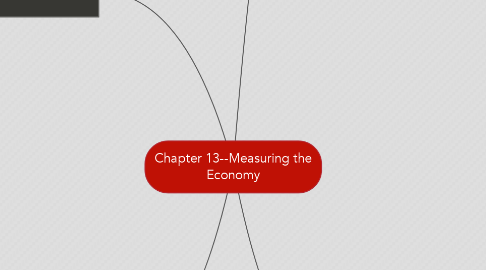
1. 13.5 -- How Does the Business Cycle Relate to Economic Health?
1.1. Leading Indicators
1.1.1. Measures that consistently rise or fall several months before an expansion or contraction begins
1.1.2. Begin a recession or depression.
1.2. Coincident Indicators
1.2.1. Rise and fall along with expansions or contractions.
1.3. Lagging Indicators
1.3.1. Measures that consistently rise or fall months after an expansion or contraction
1.4. Key Terms:
1.4.1. Leading Economic Indicators
1.4.1.1. measures that consistently rise or fall several months before an expansion or a contraction begins.
1.4.2. Lagging Economic Indicators
1.4.2.1. measures that consistently rise or fall several months after an expansion or contraction begins.
1.4.3. Recession
1.4.3.1. a period of declining national economic activity, usually measured as a decrease in GDP for at least two consecutive quarters (six months)
1.4.4. Depression
1.4.4.1. a prolonged economic downturn characterized by plunging real GDP and extremely high unemployment
1.5. The article is about a mans concern about another possible regression in the business cycle due to how they change, he was worried about the business cycle changing.
2. 13.4 -- What Does the Inflation Rate Reveal About an Economy’s Health?
2.1. Inflation
2.1.1. Inflation means economy isn't doing well
2.1.2. Increased risk in economy
2.2. Nominal Vs Real Cost of Living
2.3. Demand-Pull vs Cost-Push Inflation
2.3.1. Demand-pull=Rise in price increase in demand
2.3.2. Cost-Push=Rise in price, increase in cost of factors
2.4. Terms:
2.4.1. Deflation
2.4.1.1. a fall in the price of goods and services; the opposite of inflation.
2.4.2. Demand-pull inflation
2.4.2.1. a rise in the price of goods and services caused by an increase in overall demand.
2.4.3. Cost-Push Inflation
2.4.3.1. a rise in the price of goods and services caused by increases in the cost of the factors of production.
2.4.4. Nominal Cost of Living
2.4.4.1. the cost in current dollars of all the basic goods and services needed by the average consumer.
2.4.5. Real Cost of Living
2.4.5.1. the cost in constant dollars of all the basic goods and services needed by the average consumer; the nominal cost of living adjusted for inflation.
3. 13.2 -- How Do Economists Measure the Size of an Economy?
3.1. Gross Domestic Product
3.1.1. Indicators of Well-being
3.1.1.1. Literacy Rate
3.1.1.2. Life Expectancy
3.1.1.2.1. Less children dying due to lack of necessities.
3.1.1.3. Standard of living
3.1.1.3.1. More comfortable
3.1.2. Market Value
3.2. Inflation Influences
3.2.1. Nominal GDP
3.2.1.1. Measures the output of economy valued at today's prices
3.2.2. Real GDP
3.2.2.1. Measures the output of economy valued at constant dollars.
3.3. Per Capita GDP
3.3.1. Real GDP divided by its population
3.3.2. Based on populations impact on economy.
3.4. Key Terms
3.4.1. Gross Domestic Product
3.4.1.1. Market value of all final goods and services produced within a country during a given period of time.
3.4.2. Inflation
3.4.2.1. An increase in the overall price of goods and services produced in an economy.
3.4.3. Per Capita GDP
3.4.3.1. A nation’s real GDP divided by its population; a measure of average economic output per person.
3.5. Picture
4. 13.3 -- What Does the Unemployment Rate Tell Us About an Economy’s Health?
4.1. Unemployment Rate
4.1.1. Types of Unemployment:
4.1.1.1. People who are transitioning jobs
4.1.1.2. People who have left one job and searching for another
4.1.1.3. Seasonal employees
4.1.1.4. People who lose and gain jobs based on period of incline or decline in business cycle
4.2. Job Availability
4.2.1. If more jobs are available, more people have jobs, then they can pay for more.
4.2.2. Job Availability
4.2.2.1. Jobs=Money=Happiness
4.2.2.2. No Jobs=No money=Not very happy
4.3. Discouraged Workers
4.3.1. Don't look for jobs, so they don't get jobs
4.3.2. Don't get money, don't contiribute to economy much
4.4. Key Terms:
4.4.1. Unemployment Rate
4.4.1.1. the percentage of the labor force that is not employed but is actively seeking work.
4.4.2. Frictional Unemployment
4.4.2.1. a type of unemployment that results when workers are seeking their first job or have left one job and are seeking another.
4.4.3. Structural Unemployment
4.4.3.1. a type of unemployment that results when the demand for certain skills declines, often because of changes in technology or increased foreign competition; under such conditions, workers may need retraining to find new jobs.
4.4.4. Seasonal Unemployment
4.4.4.1. a type of unemployment that results when businesses shut down or slow down for part of the year, often because of weather.
4.4.5. Cyclical Unemployment
4.4.5.1. a type of unemployment that results from a period of decline in the business cycle; unemployment caused by a contraction.
4.4.6. Discouraged Workers
4.4.6.1. unemployed workers who have ceased to look for work; discouraged workers are not considered part of the labor force and are not factored into the unemployment rate.
4.5. Picture
4.5.1. Job
